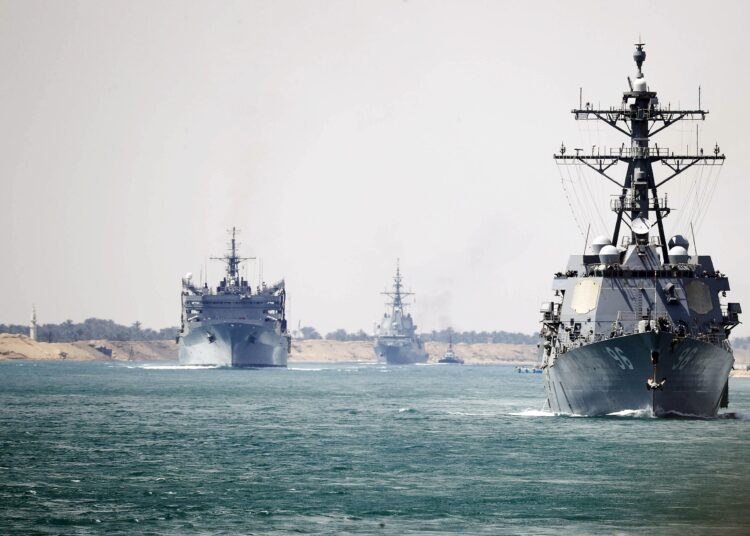In light of a non-aggression stance, what rationale underpins the escalating American military presence within the Persian Gulf? A deeper scrutiny of recent developments in the region provides an insight into this state of affairs.
By: Jafar Sherdoost
Not so long ago, an announcement from the US defense officials spelt out their intent to bolster their presence in the Persian Gulf, dispatching additional Marines and a number of fighter jets to the region. Such a move sent ripples across the media sphere. Concurrently, high-ranking American officials, including National Security Adviser, Jake Sullivan, engaged in discourse with senior officials of the region, making diplomatic tracks to Saudi Arabia and poised to do the same with the United Arab Emirates. The upper echelons of the US Fifth Fleet, currently harbored in the region, embarked on diplomatic missions to Arab capitals, liaising with their corresponding and other senior officials.
At first, this sequence might portend a looming military showdown with Iran. A fortified military presence, trips by commanding officers to Arab capitals, and show of unity and normalization tendencies between Arab countries, including Saudi Arabia, and Israel all seem to be directed at such a scenario.
Yet, contrary references suggest a different interpretation. Far from being an active policy stance in the region, these recent activities seem to reflect a passivity on Washington’s part toward unfolding events.
Initially, the speculation of an imminent military conflict in the region led by the US seems incongruous with prevailing circumstantial realities. Wading into a skirmish pitted against tackling Russian antics in Ukraine whilst jostling with China on multiple fronts is unlikely to be a path that the US would willingly tread. Elements such as the war’s repercussion and scope, the unpredictability it would spawn, and the precautionary agreement between Washington and Tehran on the exchange of prisoners and the release of a portion of Iran’s frozen assets, underscore the US’s intent to refrain from augmenting genuine tension with Iran whilst preserving paths of interaction to maintain a controlled scenario.
So, what factors spur the US to amplify its military might in a region devoid of impending conflict? As before, an exploration of recent unfolding events in the region sources the answer. The alignment of Iran and Saudi Arabia exposes a new path for regional developments, effectively rerouting efforts away from a normalization procedure between Saudi Arabia and Israel, whilst concurrently elevating China’s role. The US’ waning reliance on Middle Eastern oil reserves coupled with a surge of new global priorities has catalyzed their shifting gaze towards other territories like Ukraine and East Asia. This pivot has granted fresh platforms for burgeoning global player, China, whilst simultaneously potentially jeopardizing America’s long-standing interests in the region.
Furthermore, Saudi Arabia, the long-standing partner and confidante of America within the region, has brokered a deal with Iran, its regional adversary. This shift has set off a domino effect accelerating an amicable process between Arab capitals and Damascus, setting precedence for diplomatic ties improvement with Tehran among other Arab nations. The array of activities in Yemen, Iraq, Syria and Lebanon, and the strategic positioning of Iran-affiliated forces in these areas affirm Iran’s expanding power in the region, a development that neither Washington nor its allies see fit.
Israel presently grapples with significant adversities both domestically and at the regional level. The precarious state of the Abraham Accords juxtaposed with the radical initiatives of the extant cabinet in Tel Aviv, supplemented with continuous protests, bode ill for both Israel and the United States. A decline in US dominance within the region and a deteriorating united axis could potentially nudge regional trends toward a novel tangent. This evolving trend has precipitated Riyadh’s drive for eastern alliances and neighboring connections under the banner of diversified relations. Nonetheless, such a policy invites a substantial expense for Saudi Arabia. Take, for instance, the covert pressure from the United States resulting from its agreement with Iran. Washington endeavors to obstruct the path of interaction between Tehran and Riyadh. The visit of the Central Intelligence Agency (CIA) director, William Burns, following the Iranian-Saudi pact inked in Beijing offered the initial glaring evidence of American anxieties and pressure exerted on Saudi Arabia.
In an attempt to weave developments to its advantage, the US tempts with incentives and insists on facilitating the normalization process between Riyadh and Tel Aviv. However, it appears Saudi Arabia has set forth stringent conditions and hefty costs for such a scenario, which may prove challenging for the US to meet. Reflecting on the gradual divorce of paths between America and Saudi Arabia, Time Magazine remarks, “Both Washington and Riyadh still signal discomfort with this trajectory. But there will be increasingly little they can do to arrest it.”
In executing its recent actions, the Biden administration attempts to simultaneously score two goals. It endeavors to market the concept of normalization with Israel to the Jewish lobby, thereby enhancing its electoral prospects. Concurrently, it wishes to manipulate the regional equilibrium in favor of Israel and itself.
In essence, the US endeavors to shrink the gains accrued to Tehran and its allies arising from recent regional trends through the securitization of the region. It aims to reshuffle the cooperative atmosphere that prevails among regional capitals while also projecting a reassuring message to its allies about its abiding presence and maintained foothold in the region. There’s a looming dread within Washington that a growing emphasis on American regional withdrawal could trigger long-term trends that steadily erode American interests over time. The deployment of US military forces to the region might arguably be assessed in this light.
Regardless, managing the scenario at hand is hardly a cakewalk for Washington. In its desire to avoid stirring a hornet’s nest that could escalate into warfare and conflict, the US treads carefully, seeking to diminish tension with Iran across certain areas. But on another front, it strategically incites tension to handicap Tehran and its competitors from capitalizing significantly on the prevailing regional circumstances. A recurrent US strategy over the years has been to instigate fear in regional capitals by igniting a crisis, subsequently selling solutions such as arms or a preferable political outcome to them. In this instance, the US attempts to instill fear to widen the rift between regional capitals and Tehran, evading losses while reaping benefits from the coffers of Arab capitals. Consequently, the spectacle of the US dispatching additional military forces to the region triggers instability rather than fostering security, a circumstance woefully detrimental to the interests and growth of regional countries.
The views expressed in this article are those of the author and do not necessarily reflect the positions of Iran Nuances.





